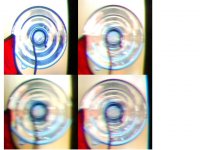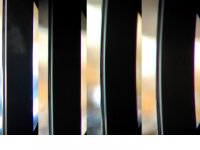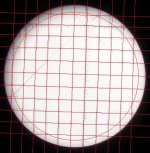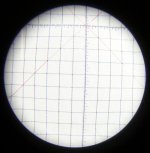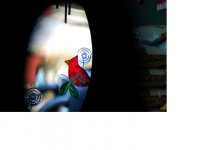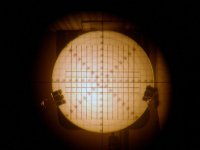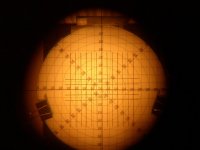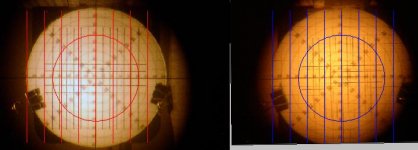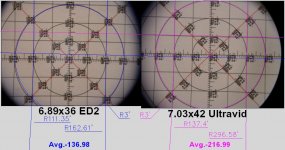henry link
Well-known member
Last month I photographed the distortion characteristics of four expensive roof prism binoculars: The new "Swarovision" 8.5x42, Nikon 8x42 EDG, Zeiss 4x42 FL and Leica 8x42 Ultravid. I'm just now getting around to making slides that demonstrate the differences among them.
I used two targets that were handy in the store; a round suction cup to show the effect on shapes of angular magnification distortion and and a straight window frame to show the curving of lines caused by the pincushion form of rectilinear distortion used in binoculars. What you can see from the photos is that none of the binoculars is distortion free. In fact that is impossible. If rectilinear distortion is reduced to zero that creates angular magnification distortion. Achieving relative freedom from angular magnification distortion is only possible by the application of pincushion distortion. The problem is similar to what map makers face in trying to produce a flat map of the sphere of the earth.
The left slide shows the angular magnification distortion of a circular shape at the edge of the field. Swaro is upper left, Nikon is upper right, Zeiss is lower left and Leica lower right. The Zeiss is the most nearly distortion free which in this case means a perfect circle with the horizontal and vertical diameters equal. The Swaro has the highest angular magnification distortion because it has virtually no pincushion distortion, so the circle appears as if it were seen from an oblique angle. The Leica has a little too much pincushion for exact compensation so that the horizontal diameter of the circle is wider than the vertical diameter, essentially reverse angular magnification distortion.
The right slide (Sorry, that slide is in post # 2) shows the rectilinear distortion of the window frame. Swaro is on the far left, then moving right Nikon, Zeiss and Leica. The Swaro has virtually no rectilinear distortion and the Nikon has a very little pincushion. The Zeiss and Leica show increasing amounts of pincushion which is more obvious in viewing through the Leica because its apparent field is smaller.
The designers of these binoculars made different decisions about distortion. The Swarovski designers made an unusual choice of zero pincushion which leads to considerable angular magnification distortion. The Nikon designers applied slight pincushion which leaves a little angular magnification distortion, but doesn't cause lines to curve very much. Zeiss applied more pincushion which mostly correct angular magnification distortion but causes lines to visibly curve and Leica, for reasons I don't understand, applied a little more pincushion than is really needed.
I used two targets that were handy in the store; a round suction cup to show the effect on shapes of angular magnification distortion and and a straight window frame to show the curving of lines caused by the pincushion form of rectilinear distortion used in binoculars. What you can see from the photos is that none of the binoculars is distortion free. In fact that is impossible. If rectilinear distortion is reduced to zero that creates angular magnification distortion. Achieving relative freedom from angular magnification distortion is only possible by the application of pincushion distortion. The problem is similar to what map makers face in trying to produce a flat map of the sphere of the earth.
The left slide shows the angular magnification distortion of a circular shape at the edge of the field. Swaro is upper left, Nikon is upper right, Zeiss is lower left and Leica lower right. The Zeiss is the most nearly distortion free which in this case means a perfect circle with the horizontal and vertical diameters equal. The Swaro has the highest angular magnification distortion because it has virtually no pincushion distortion, so the circle appears as if it were seen from an oblique angle. The Leica has a little too much pincushion for exact compensation so that the horizontal diameter of the circle is wider than the vertical diameter, essentially reverse angular magnification distortion.
The right slide (Sorry, that slide is in post # 2) shows the rectilinear distortion of the window frame. Swaro is on the far left, then moving right Nikon, Zeiss and Leica. The Swaro has virtually no rectilinear distortion and the Nikon has a very little pincushion. The Zeiss and Leica show increasing amounts of pincushion which is more obvious in viewing through the Leica because its apparent field is smaller.
The designers of these binoculars made different decisions about distortion. The Swarovski designers made an unusual choice of zero pincushion which leads to considerable angular magnification distortion. The Nikon designers applied slight pincushion which leaves a little angular magnification distortion, but doesn't cause lines to curve very much. Zeiss applied more pincushion which mostly correct angular magnification distortion but causes lines to visibly curve and Leica, for reasons I don't understand, applied a little more pincushion than is really needed.
Attachments
Last edited:




